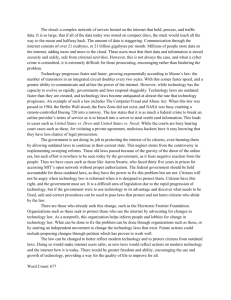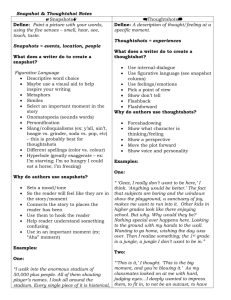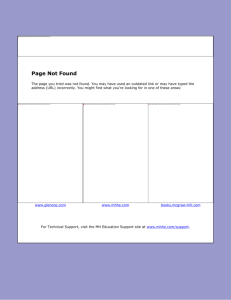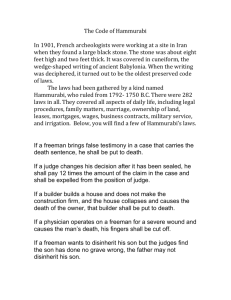Vetting the Links of the Web Na Dai Brian D. Davison
advertisement
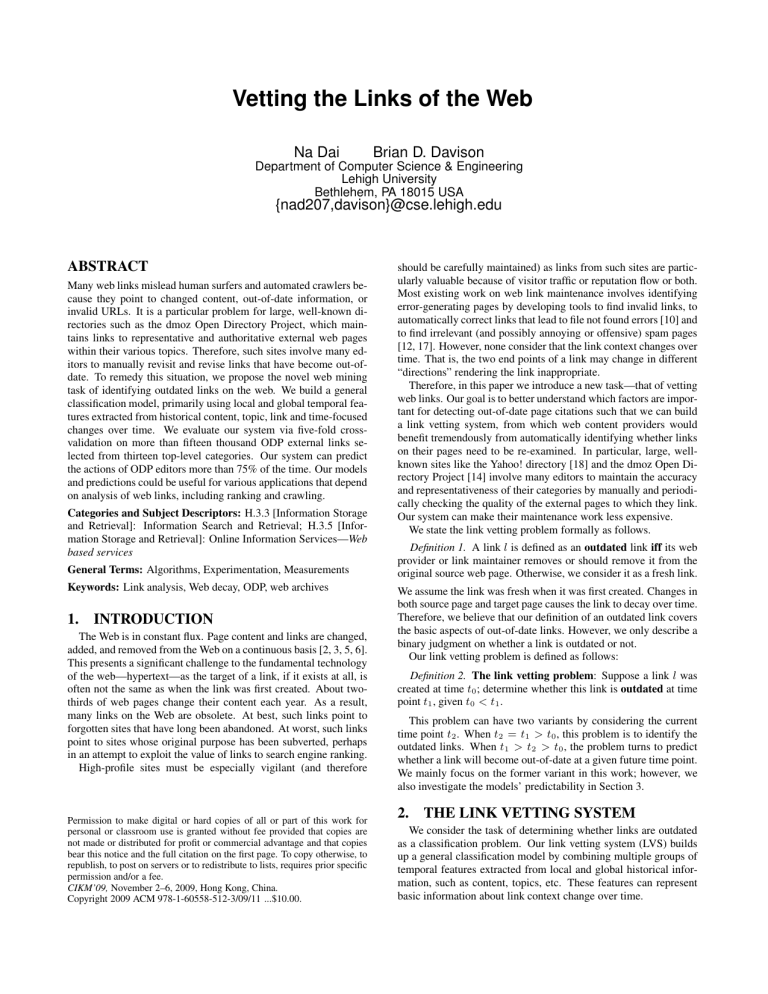
Vetting the Links of the Web
Na Dai
Brian D. Davison
Department of Computer Science & Engineering
Lehigh University
Bethlehem, PA 18015 USA
{nad207,davison}@cse.lehigh.edu
ABSTRACT
Many web links mislead human surfers and automated crawlers because they point to changed content, out-of-date information, or
invalid URLs. It is a particular problem for large, well-known directories such as the dmoz Open Directory Project, which maintains links to representative and authoritative external web pages
within their various topics. Therefore, such sites involve many editors to manually revisit and revise links that have become out-ofdate. To remedy this situation, we propose the novel web mining
task of identifying outdated links on the web. We build a general
classification model, primarily using local and global temporal features extracted from historical content, topic, link and time-focused
changes over time. We evaluate our system via five-fold crossvalidation on more than fifteen thousand ODP external links selected from thirteen top-level categories. Our system can predict
the actions of ODP editors more than 75% of the time. Our models
and predictions could be useful for various applications that depend
on analysis of web links, including ranking and crawling.
Categories and Subject Descriptors: H.3.3 [Information Storage
and Retrieval]: Information Search and Retrieval; H.3.5 [Information Storage and Retrieval]: Online Information Services—Web
based services
General Terms: Algorithms, Experimentation, Measurements
Keywords: Link analysis, Web decay, ODP, web archives
1.
INTRODUCTION
The Web is in constant flux. Page content and links are changed,
added, and removed from the Web on a continuous basis [2, 3, 5, 6].
This presents a significant challenge to the fundamental technology
of the web—hypertext—as the target of a link, if it exists at all, is
often not the same as when the link was first created. About twothirds of web pages change their content each year. As a result,
many links on the Web are obsolete. At best, such links point to
forgotten sites that have long been abandoned. At worst, such links
point to sites whose original purpose has been subverted, perhaps
in an attempt to exploit the value of links to search engine ranking.
High-profile sites must be especially vigilant (and therefore
Permission to make digital or hard copies of all or part of this work for
personal or classroom use is granted without fee provided that copies are
not made or distributed for profit or commercial advantage and that copies
bear this notice and the full citation on the first page. To copy otherwise, to
republish, to post on servers or to redistribute to lists, requires prior specific
permission and/or a fee.
CIKM’09, November 2–6, 2009, Hong Kong, China.
Copyright 2009 ACM 978-1-60558-512-3/09/11 ...$10.00.
should be carefully maintained) as links from such sites are particularly valuable because of visitor traffic or reputation flow or both.
Most existing work on web link maintenance involves identifying
error-generating pages by developing tools to find invalid links, to
automatically correct links that lead to file not found errors [10] and
to find irrelevant (and possibly annoying or offensive) spam pages
[12, 17]. However, none consider that the link context changes over
time. That is, the two end points of a link may change in different
“directions” rendering the link inappropriate.
Therefore, in this paper we introduce a new task—that of vetting
web links. Our goal is to better understand which factors are important for detecting out-of-date page citations such that we can build
a link vetting system, from which web content providers would
benefit tremendously from automatically identifying whether links
on their pages need to be re-examined. In particular, large, wellknown sites like the Yahoo! directory [18] and the dmoz Open Directory Project [14] involve many editors to maintain the accuracy
and representativeness of their categories by manually and periodically checking the quality of the external pages to which they link.
Our system can make their maintenance work less expensive.
We state the link vetting problem formally as follows.
Definition 1. A link l is defined as an outdated link iff its web
provider or link maintainer removes or should remove it from the
original source web page. Otherwise, we consider it as a fresh link.
We assume the link was fresh when it was first created. Changes in
both source page and target page causes the link to decay over time.
Therefore, we believe that our definition of an outdated link covers
the basic aspects of out-of-date links. However, we only describe a
binary judgment on whether a link is outdated or not.
Our link vetting problem is defined as follows:
Definition 2. The link vetting problem: Suppose a link l was
created at time t0 ; determine whether this link is outdated at time
point t1 , given t0 < t1 .
This problem can have two variants by considering the current
time point t2 . When t2 = t1 > t0 , this problem is to identify the
outdated links. When t1 > t2 > t0 , the problem turns to predict
whether a link will become out-of-date at a given future time point.
We mainly focus on the former variant in this work; however, we
also investigate the models’ predictability in Section 3.
2. THE LINK VETTING SYSTEM
We consider the task of determining whether links are outdated
as a classification problem. Our link vetting system (LVS) builds
up a general classification model by combining multiple groups of
temporal features extracted from local and global historical information, such as content, topics, etc. These features can represent
basic information about link context change over time.
Notation
d
s
t0
tn
Ti
C(d)Ti
C(s)Ti
Meaning
A target page
A source page
the time point that the link (d–>s) was created
the time point that the link (d–>s) is outdated and removed
the ith time interval/unit
the snapshot of a target page in the ith time interval/unit
the snapshot of a source page in the ith time interval/unit
Table 1: Notation definitions.
2.1 Using historical snapshots
In order to map link context changes onto a time axis, we discretize time into multiple intervals. We use a page snapshot at one
time point to represent the page situation during the time interval
which covers that time point. While the time interval could be measured by any time units, we use Year as our basic unit to measure
link context change. We base our work on the assumption that a
link was fresh when it was first created. By comparing the snapshot for each time unit with that for the first time unit and successive time units, we can know how the page changes over the time
units, and potentially know whether such changes make the links
between pages stronger or weaker.
Table 1 defines some notation. We use the following metrics to
measure the difference between two snapshots:
• Jaccard Coefficient: JC(A, B) =
T
|A S B|
|A B|
• Element Removal Coefficient: ERC(A, B) =
• Element Addition Coefficient: EAC(A, B) =
P
−
−
• L1 Distance: L1 (→
u,→
v )) = m
j=1 |uj − vj |
|A−B|
|A|
|B−A|
|A|
−
where A and B are two sets which contain some elements, and →
u
→
−
and v are two vectors with m dimensions.
2.2 Features
Our features are extracted from the changes of title, meta information, content, link, topicality (defined in Section 2.2.2) and the
fraction of words in our predefined list. These changes are determined by the comparison between different historical snapshots of
both source pages and target pages. Most of these features emphasize the comparison between snapshots. The main feature list is
listed in Table 2.
2.2.1 Local Features
Local features are organized to represent the characteristics of
link context changes over time.
Features based on title, meta information and content. We
use the downloaded snapshots for each target page and collect the
terms in different page fields, such as title, keywords, description
and content. We use JC, ERC and EAC (see Section 2.1) in each
field as our features to compare the similarity between two snapshots. For meta information recorded by the IA, we also check
finer fields within it, including HTML content base, returned HTTP
status code and so on, which reflect the state of the target page.
Features based on time measures. This group of features represents the time information hidden in the content of historical snapshots. We treat “Year” as the atomic time unit, and extract all the
time information which is presented by year, such as 1999, 2000
and so on. Combining the last-modified time in meta information
(about 60% of the pages show last-modified time in returned HTTP
information), we calculate a time-based distribution with respect
to each snapshot. We use the L1 distance between two compared
snapshots as our features to represent time evolution.
Feature
Description
Title, meta information and content
T/M/C_SC
JC(C(d)T1 /Ti−1 , C(d)Ti ),
ERC(C(d)T1 /Ti−1 , C(d)Ti ),
EAC(C(d)T1 /Ti−1 , C(d)Ti ) for title/meta/content
field
M_UF
Average update frequency of C(d)Ti and C(s)Ti
Time measures
TI_CT
Whether C(d)Ti contain time information
TI_SA
Whether C(d)T1 /Ti−1 and C(d)Ti have the same
distribution on time information
TI_TD
L1 (C(d)T1 /Ti , C(d)Ti ) of the distribution on time
information
Global bi-gram and tri-gram lists
GL_INF/TRF
the fraction of C(d)Ti ’s bi/tri-gram words that are in
the global “incomplete”/“trustworthy” list
Category
CA_TOD
L1 (C(d)T1 /Ti−1 , C(d)Ti ) of the topic distribution
under predefined taxonomy
CA_AC
L1 (C(s)T1 /Ti , C(d)Ti ) between the topic
distribution of the extended anchor text on page s and
the content of page d
Outlinks and anchor text
OA_SC
JC(C(d)T1 /Ti−1 , C(d)Ti ),
ERC(C(d)T1 /Ti−1 , C(d)Ti ),
EAC(C(d)T1 /Ti−1 , C(d)Ti ) for outgoing links
and “frameset” links
OA_NL
The number of “mailto”/“frameset” links in C(d)Ti
Topicality inferred from pre-computed language models
LM_DIST
The distance of πC(d)T ,j and p(θj ) in the j th
i
hidden topic of the outdated/fresh link context cluster
determined by the topic of C(s)Ti
Table 2: Main features for each group.
Features based on global bi-gram and tri-gram lists. We manually build up two lists composed of bi-grams and tri-grams. One
list records 45 representative phrases which show that the page content is still incomplete (e.g., “under construction”, etc.). The other
records 45 phrases which relate to the professionality or trustworthiness of the pages/snapshots (e.g., “all right reserved”, etc.). The
statistics for each of these records the presense (or absence) of that
phrase in a page snapshot under consideration. This group of features is based on the comparison of the statistics between snapshots.
Features based on category. Based on the twelve selected
top-level ODP topics, we use a well-known naive Bayes classifier
“Rainbow” [11] trained on the texts of 1000 randomly selected documents per class from the ODP. We then classify each page snapshot by the trained classifier. For each snapshot, we produce a topic
distribution vector, which presents the normalized probability that
the snapshot belongs to each topic. This group of features is calculated from the L1 distance of topic distributions between two compared snapshots, either between source and target page snapshots
in the same time unit, or between the same target page in snapshots
in two different time units.
Features based on links. This group of features checks the consistency of the outgoing links between two compared snapshots.
We also compare the information about “mailto:”, which may reflect the page’s trustworthiness to some degree. In addition, the
change of frameset information gives some clue about the probability that a page becomes a redirection or cloaking page.
2.2.2 Global Features
Global features use the knowledge based on characteristics of
members of a calculated group/cluster. They reflect the background
Category
Content
LM
Meta
Outlinks
Time
Title
Wordlist
Percentage of features per bucket
0.8
0.7
0.6
0.5
0.4
0.3
0.2
1999
2000
2001
2002
2003
2004
2005
2006
2007
0.9
0.8
0.7
0.6
0.5
0.4
0.3
0.2
0.1
0.1
0
0
1
Percentage of features per bucket
1
0.9
10
20
30
40
50
0
0
5
Bucket
10
15
20
25
30
Bucket
(a) Feature source type per (b) Feature source year per
bucket, ordered by information bucket, ordered by information
gain.
gain.
2.3 Classification Algorithms
We explore a variety of classification algorithms with respect to
their capability to detect outdated links. Specially, we select 37
classifiers implemented in the Weka toolkit [15] and evaluate them
on the proposed task in Section 3. Our selected classification algorithms include multiple classifiers in the decision tree family,
support vector machine, NaiveBayes, rule generators, boosting and
other meta-learning methods. We believe these classification algorithms can represent the state-of-the-art. Thus, by exploring these
classification algorithms, we find which classification algorithms
are suitable for this task and how well LVS can be generalized.
3. EXPERIMENTS
Figure 1: Distribution of feature discriminability with respect
to their category times and source year.
of the whole group. The deviation of features from such a background will make these extracted features more discriminative.
Features based on topicality inferred from pre-computed
language models (LMs). Given a time point t1 , we calculate separate language models based on the content corresponding to outdated link context and fresh link context respectively. Our hope is
that we train a set of outdated topics from outdated link contexts,
and a set of fresh topics from fresh link context for each time point,
and track how close the topical distribution of an unseen link context is to these two sets of topics and how these distances change
over time.
We first cluster the link contexts into different groups, with each
sharing some similar characteristics. The reason is that the outdated
topics and/or the fresh topics should be different among groups.
Hence, we group link contexts according to the category of source
pages or the anchor text on them. For each group, we compute
separate sets of latent topic-specific language models from all the
snapshots of the target pages within the link contexts in that group,
with one calculated by using those involved in outdated link contexts and the other one by the target page snapshots in fresh link
contexts. Define w as a word in the dictionary. Define θ1 , . . . , θk
as unigram language models for k topics. πd,j is the mixture weight
P
( kj=1 πd,j = 1). We use the EM algorithm in pLSA [7] to estimate the parameters πd,j for each snapshot and p(w|θj ).
Next, we define the topic centroid of the P
outdated or fresh link
contexts of the ith cluster/group as |C 1 ′ | d∈C ′ πd,j , where
i,s
i,s
s′ ∈ {fresh, outdated} and Ci,s′ represents the corpus composed
of all the page snapshots involved in the link contexts of the ith
cluster. We use the topic centroid as our estimation of p(θj ). Given
a unseen link context, we estimate πd,j of involved page snapshot
content by the pre-computed language models. Bayes’ rule infers
p(θ̂j |w) =
p(w|θj )p(θ̂j )
p(w|θj )p(θ̂j )
= Pk
′
′
p(w)
′
j =1 p(w|θj )p(θ̂j )
where p(θ̂j |w) unravels the contribution of w to the j th hidden
P
1
subtopic. Therefore, the π̂d,j can be given by |d|
w∈d p(θ̂j |w).
We can use |π̂d,j − p(θ̂j )| to represent the distance of the j th
subtopic distribution within a link context from the background of
its clusters. Thus, this group of features tracks how far the hidden
topic distribution of a link context is from the outdated/fresh background distribution and how prominent a link context is on a particular fresh/outdated subtopic when considering the background in
different time units.
3.1 Data sets
We use the ODP data set, which is based on the external pages
cited by dmoz Open Directory Project and corresponding historical
snapshots provided by the Wayback Machine service offered by the
Internet Archive [8].
By exploring the historical ODP RDF file and content file, we
get some statistics about the external link removal. In order to set
up a realistic link vetting task, we define our task as to determine
whether the links to selected external pages will be removed by
2007 (decisions by ODP editors). We first use the 2008 ODP RDF
file to extract active categories. There are 756,439 categories in
total. We randomly select 15,910 external pages among these categories, which have complete historical snapshots from the year in
which they are first observed in the ODP directory to the year 2007
as our data set for training and testing the classifier. The removed
external pages (outdated external links) are labeled as positive examples, while those remaining are negative.
3.2 Evaluation
We first select the most suitable feature set for this task. By
basing our feature selection on Information Gain (IG), we can understand which features are more discriminative for the task. We
sample from a larger data set, excluding the 15910 examples, and
perform feature selection on it. The distributions of feature information gain with respect to their category and time units are depicted in Figure 1. The x-axis is the buckets from the ranking of
feature IG values. From Figure 1(a), the most discriminative features focus on content, LMs and title related features. Especially
the top 10 features are all from the LM group covering from 2006
to 2007. The category and meta related features gradually dominate
the bucket with the decrease of IG value rankings. Interestingly, the
features about outgoing links don’t show good discriminability in
this task. Figure 1(b) demonstrates that the feature discriminability highly correlates with the time point from which the features
formed. Earlier features show poorer discriminability.
We tried 27 different feature set sizes, and trained the 37 classifiers provided by Weka. We found most of these classifiers get
their best performance when using the top 200 discriminative features selected by IG values. Hence, we choose to present the classification performance based on these 200 features. The comparison among multiple classifiers are all based on five-fold crossvalidation, shown in Table 3. The top four classifiers for this
task are EnsembleSelection, Bagging, DecisionTable, and REPTree, where EnsembleSelection gets the best performance on all
the four metrics we used. We also list the performance of some
traditional classifiers, including C4.5 decision tree. The RandomForest classifier in decision tree family can achieve a F-measure of
0.749 while NB has the lowest F-measure and accuracy. We also
Classifier
LVS_EnsembleSelection
LVS_Bagging
LVS_DecisionTable
LVS_REPTree
LVS_RandomForest
LVS_J48
LVS_Logistic
LVS_SMO
LVS_AdaBoostM1
LVS_NaiveBayes
404Checker
Default (Majority)
Random
including 2007
F-Meas. Accu.
0.782
0.764
0.771
0.753
0.756
0.740
0.756
0.740
0.749
0.717
0.738
0.710
0.722
0.699
0.717
0.699
0.702
0.698
0.542
0.596
0.155
0.459
0.714
0.556
0.526
0.500
excluding 2007
F-Meas. Accu.
0.686
0.663
0.689
0.665
0.692
0.687
0.668
0.648
0.701
0.633
0.675
0.653
0.679
0.645
0.670
0.634
0.683
0.673
0.437
0.555
Table 3: Classification performance results on ODP dataset.
found the performance of many classifiers is quite close to the highest one. The deviation of the top 4 classifiers on F-measure is only
0.0127, which demonstrates that the system can provide a general
classification model independent of the specific classifier.
We explore the predictability of classification models by removing all the features involved in the information from 2007 (Table 3,
rightmost columns). From Table 3, all classifiers reveal an inferior
performance to those trained by all the features on both F-measure
and accuracy. In particular, Adaboost shows the best capability
of prediction of future outdated links, with only a 2.7% decrease
in F-measure performance. In contrast, NB shows the worst predictability performance since its F-measure score decreases 19.4%.
4.
RELATED WORK
Web link maintenance involves significant manual labor to detect
outdated links based on complex and diverse criteria. Existing research work on web link maintenance, using only a snapshot of the
current web, typically focuses on one specific criteria for detecting
pages/links which violate it. Tools such as W3C Link Checker [16]
can automatically identify error generating pages. Some recent research work extends this task by automatically correcting broken
links on the web [9, 10].
Some researchers extracted useful temporal data for web information retrieval tasks. Nunes [13] identifies temporal web evidence
by using two classes of features based on individual information
and global information. They also propose several sources of temporal web evidence, including document-based and web-based evidence, which can be utilized in improving multiple retrieval tasks.
Researchers at Google filed a patent [1] on using historical information for scoring and spam detection. Berberich et al. [4] propose
two temporal link analysis ranking algorithms which incorporate
pages’ temporal freshness (timestamps of most recent updates) and
activity (update rates), and improves ranking performance. Yu et
al. [19] incorporate temporal factors to overcome the problem that
traditional link analysis approaches favor old pages by introducing
a temporal weight into the PageRank algorithm, which decreases
exponentially with citation age.
5.
CONCLUSION
Many web links reflect choices and information that, while valid
at time of link creation, are now woefully out-of-date. In this work
we have proposed a new web mining task of vetting web links. As
an initial attempt to satisfy this task for links of the ODP directory,
we have presented a classification performance comparison among
a variety of state-of-the-art classifiers on this task, trained by tem-
poral features extracted from the historical link context, including
content, category, and link-based information from historical snapshots of both source and target pages. Our proposed system is able
to achieve a F-measure of 0.782 when compared to ODP editor
removal actions. This evidence suggests that, with sufficient, coherent archival data, it is possible to vet automatically many links
of the web, and points the way to new tools to help maintain the
accuracy of the Web, benefitting various applications that depend
on analysis of web links beyond web site maintenance, including
crawling, ranking, and classification.
Acknowledgments
This work was supported in part by a grant from the National Science Foundation under award IIS-0803605 and an equipment grant
from Sun Microsystems. We also thank Dennis Fetterly, Liangjie
Hong, Gordon Mohr and Xiaoguang Qi for helpful feedback.
6. REFERENCES
[1] A. Acharya, M. Cutts, J. Dean, P. Haahr, M. Henzinger, U. Hoelzle,
S. Lawrence, K. Pfleger, O. Sercinoglu, and S. Tong. Information
retrieval based on historical data. United States Patent 20050071741,
USPTO, Mar. 2005.
[2] R. A. Baeza-Yates, C. Castillo, and F. Saint-Jean. Web structure,
dynamics and page quality. In M. Levene and A. Poulovassilis,
editors, Web Dynamics: Adapting to Change in Content, Size,
Topology and Use, pages 93–115. Springer-Verlag, Berlin, 2004.
[3] Z. Bar-Yossef, A. Z. Broder, R. Kumar, and A. Tomkins. Sic transit
gloria telae: Towards an understading of the web’s decay. In Proc.
13th Int’l World Wide Web Conf., pages 328–337, May 2004.
[4] K. Berberich, M. Vazirgiannis, and G. Weikum. Time-aware
authority ranking. Internet Mathematics, 2(3):301–332, 2005.
[5] J. Cho and H. Garcia-Molina. Estimating frequency of change. ACM
Transactions on Internet Technology, 3(3):256–290, Aug. 2003.
[6] D. Fetterly, M. Manasse, M. Najork, and J. L. Wiener. A large-scale
study of the evolution of web pages. Software: Practice and
Experience, 34(2):213–237, 2004.
[7] T. Hofmann. Probabilistic Latent Semantic Analysis. In Proc. of the
15th Annual Conf. on Uncertainty in Artificial Intelligence (UAI),
pages 289–296. Morgan Kaufmann, July 1999.
[8] The Internet Archive, 2009. http://www.archive.org/.
[9] J. Martinez-Romo and L. Araujo. Recommendation system for
automatic recovery of broken web links. In IBERAMIA ’08:
Proceedings of the 11th Ibero-American conference on AI, pages
302–311, Berlin, Heidelberg, 2008. Springer-Verlag.
[10] J. Martinez-Romo and L. Araujo. Retrieving broken web links using
an approach based on contextual information. In Proc. 20th ACM
Conf. on Hypertext, pages 351–352, 2009.
[11] A. K. McCallum. Bow: A toolkit for statistical language modeling,
text retrieval, classification and clustering.
http://www.cs.cmu.edu/˜mccallum/bow, 1996.
[12] A. Ntoulas, M. Najork, M. Manasse, and D. Fetterly. Detecting spam
web pages through content analysis. In Proc. 15th Int’l Conf. on the
World Wide Web, pages 83–92, May 2006.
[13] S. Nunes. Exploring temporal evidence in web information retrieval.
In BCS IRSG Symposium: Future Directions in Information Access
(FDIA). British Computer Society, 2007.
[14] The dmoz Open Directory Project (ODP), 2009.
http://www.dmoz.org/.
[15] I. H. Witten and E. Frank. Data Mining: Practical Machine Learning
Tools and Techniques. Morgan Kaufmann, San Francisco, 2nd
edition, June 2005.
[16] World Wide Web Consortium. W3C link checker. Online at
http://validator.w3.org/checklink, visited 2
November 2008, 2006.
[17] B. Wu and B. D. Davison. Identifying link farm spam pages. In Proc.
14th Int’l World Wide Web Conf., pages 820–829, May 2005.
[18] Yahoo!, Inc. Yahoo! directory. http://dir.yahoo.com/, 2009.
[19] P. S. Yu, X. Li, and B. Liu. On the temporal dimension of search. In
Proc. 13th Int’l World Wide Web Conf., pages 448–449, May 2004.
